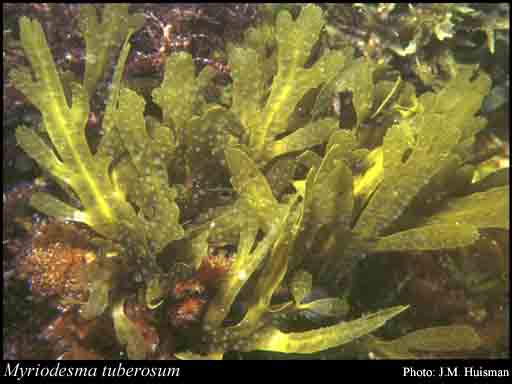- Reference
- Acta Univ.Lund. 93 (1894)
- Conservation Code
- Not threatened
- Naturalised Status
- Native to Western Australia
- Name Status
- Current

Scientific Description
Habit and structure. Thallus light to medium brown, 10–25 cm long, with usually two complanately branched fronds from the branched stipe. Holdfast discoid-conical, 4–8 mm across; epilithic. Stipe 2–10 cm long, with di- (or tri-)chotomies at intervals of 1–3 cm, each 1.5–2(–3) mm in diameter. Fronds 10–15 cm long, irregularly pinnate, with alternate branches 1–4 cm apart, 6–12 mm broad in mid parts, 3–6 mm broad in laterals, upper parts prominently serrate, less so below with slightly undulate margins, laterals not or slightly basally constricted; midrib present throughout, prominent below. Structure of fronds 300–500 µmand 8–10 cells thick, with a slight central medulla and an inactive meristoderm.
Reproduction. Thalli monoecious. Conceptacles scattered over terminal branches, prominent, bisexual, with a slight basal tuft of phaeophycean hairs; oogonia sessile, ovoid, 80–110 µmlong and 35–50 µmin diameter; antheridia sessile or on branched paraphyses, elongate-ovoid, 16–24 µm long and 8–12 µmin diameter.
Distribution.From Horrocks Beach, W. Aust., to Port Elliot, S. Aust.
Habitat. M. tuberosum is a deep water species, apparently rare.
[After Womersley, Mar. Benthic Fl. Southern Australia II: 414–416 (1987)]
Distribution
- IBRA Regions
- Geraldton Sandplains.
- IBRA Subregions
- Geraldton Hills.
- IMCRA Regions
- Central West Coast, Eucla, Leeuwin-Naturaliste, WA South Coast.
- Local Government Areas (LGAs)
- Dandaragan, Esperance, Northampton, Rockingham.